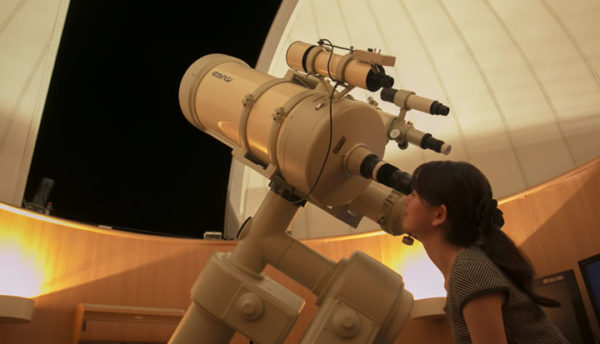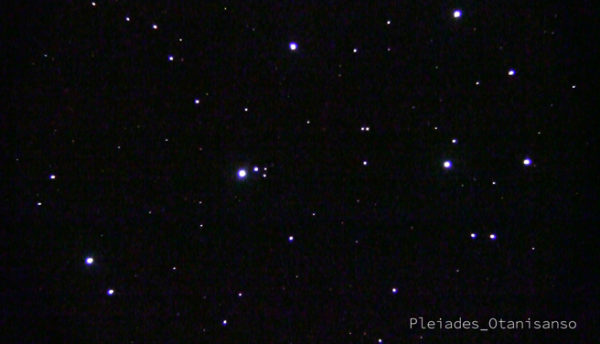- Astronomical Observatory
- 2019/10/12
【October in the Observatory】The Night of the Full Moon and the Double Cluster in the constellation of Perseus. Come and enjoy the autumn nights!
The brilliance of the moon on the Night of the Full Moon, and the mysterious glimmer of the Double Cluster of Perseus. In the lengthening autumn nights, come see if you can find their beautiful shimmering light.
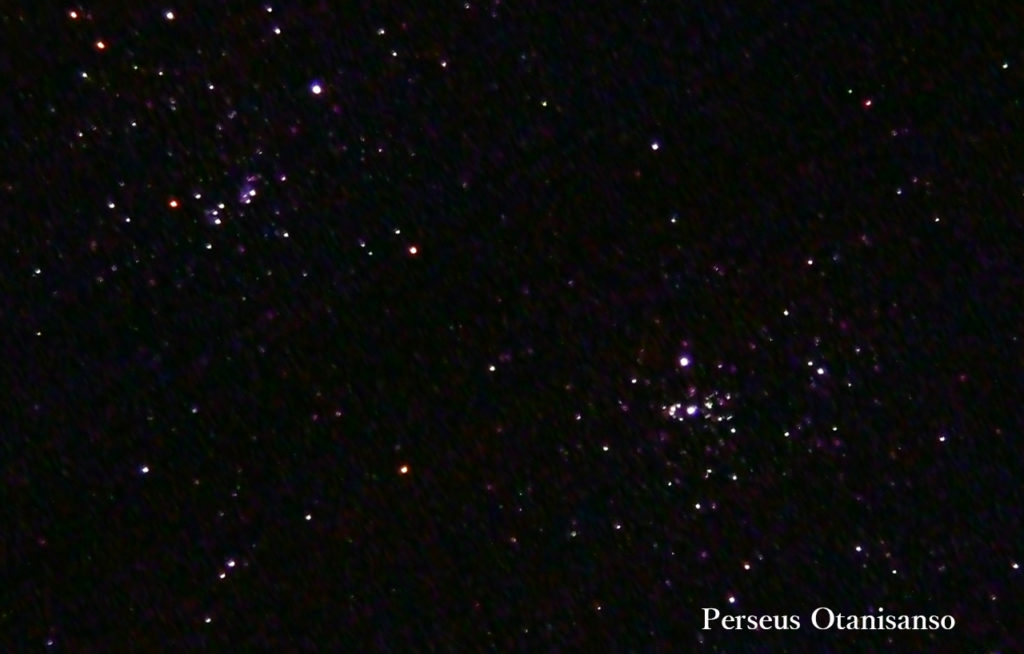 Hello, this is the Otani Sanso Astronomical Observatory Dome.Today we’ll be discussing what’s visible in Nagato Yumoto Onsen’s night skies in October, 2019. (Image: A photograph of the Perseus constellation’s Double Cluster, taken through the telescope at Otani Sanso’s astronomical observatory dome in the past)
Hello, this is the Otani Sanso Astronomical Observatory Dome.Today we’ll be discussing what’s visible in Nagato Yumoto Onsen’s night skies in October, 2019. (Image: A photograph of the Perseus constellation’s Double Cluster, taken through the telescope at Otani Sanso’s astronomical observatory dome in the past)
Take a look a the mysterious light of the young stars in the Double Cluster through our telescope, laid against the shimmering background of the Milky Way
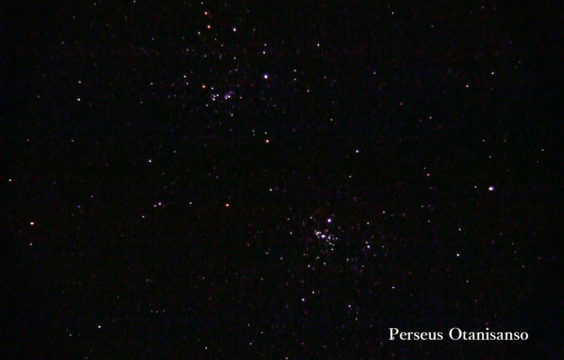
Beginning around October 17th, we will begin to be able to see the beautiful glimmer of the Double Cluster in the Perseus Constellation. Two masses of nearly 300 young stars cluster together here, each emitting a blue-white light that shimmers remarkably in the night sky. The Double Cluster is located on the northern edge of the Perseus Constellation, close to the boundary of Cassiopeia, and shining against a background of the Milky Way. If you observe it through a telescope, the Milky Way behind it emits an even more mystical shimmer, drawing you in with its beauty. It seems that one can make out the Double Cluster with the naked eye, too, but we highly recommend taking a look at it through a telescope, together with the Milky Way. Another beautiful shining light we’d like you to take a look at in October is the “Night of the Full Moon” (the moon of the 13th day of the 9th lunar month). This moon is known as the next beautiful moon to following the Harvest Moon, and in 2019 we’ll be able to see it on October 11th. Unlike the Harvest Moon, the moon on the Night of the Full Moon will not actually be a full moon. This is a custom born from the Japanese love for the beauty of the imperfect. The month of the Night of the Full Moon sees a relatively large number of clear days, and because the likelihood of catching a clear view of the moon are so much higher, it is even said that, “There are no clouds on the Night of the Full Moon.”
» See more about the Double Cluster of the Perseus Constellation (Japanese only)
Stories related to the October stars: Japan’s unique tradition of the “Night of the Full Moon”
It’s actually the perfect season for moon-gazing
The “Night of the Full Moon” is a night of moon-viewing that was traditionally held on the 13th day of the 9th month of the old lunar calendar, the next beautiful moon following the Harvest Moon. The “Night of the Full Moon” originates in Han China, and the traditions of the Mid-Autumn Festival, which began in China and came to Japan during the Heian Period (794-1185). The “Night of the Full Moon” became its own tradition unique to Japan, and is said to have begun with a moon banquet held by Kanpyo Ho-o (Emperor Uda) in the Heian Period (there are also theories linking the tradition to harvest festivals, as it occurs in the middle of the harvest season. Because it falls in the middle of the harvest period for soy beans and chestnuts, this moon has even been called the “Soy Bean Moon” or the “Chestnut Moon”). In the 24 divisions of the solar year, this “Night of the Full Moon” falls during the “late autumn”/”early winter dew” period. The weather has begun to chill, and it’s the perfect season for moon-viewing. Just as we did with the Harvest Moon, why not come out and enjoy the “Night of the Full Moon” this October 11th (Fri), 2019?The “Night of the Full Moon” moon that isn’t actually full, and why it’s so beloved by the Japanese.
Unlike the night of the Harvest Moon, the “Night of the Full Moon” is not always, strictly speaking, a full moon. So why is it that this un-full moon is so beloved by the Japanese? Since long ago, the Japanese have had an artistic appreciation for the beauty of the imperfect. The “Night of the Full Moon” is also famous as the title of a short novel by the female author, Ichiyo Higuchi. The chilly, dignified writing of this novel perfectly brings to mind the chilly evening sky of the Night of the Full Moon. Entrust yourself to the natural flow, and experience a love for the beauty that can only be experience on this day, in this season. Surrounded by nature here at Otani Sanso, we invite you to come and enjoy this shift into autumn.Information about the stars in October
Expected Stellar Observations
- October 2nd (Wed) – 4th (Fri): Saturn, Albireo
- October 5th (Sat) – 16 (Wed): Moon, Saturn, Albireo
- October 17th (Thu) – 31(Thu): Albireo, Double Cluster in the constellation of Perseus
Star-Gazing Topics in October
- October 6 (Sun) …Waxing Moon
- October 11 (Fri) …Night of the Full Moon (the moon on the 13th night of the 9th lunar month)
- October 14 (Mon) …Full Moon
- October 21 (Mon) …Waning Moon
- October 22 (Tue) …Peak of the Orionid meteor showers
- October 28 (Mon) …New Moon
Please check the National Astronomical Observatory of Japan website for sunset times in Yamaguchi Prefecture. (See: National Astronomical Observatory of Japan Website)
Making a Reservation at the Astronomical Observatory
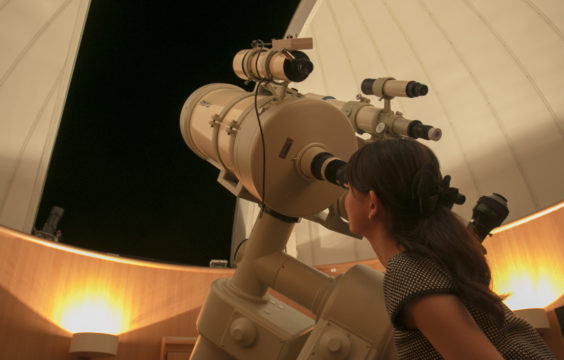
Details
- Observatory Hours… 7:30 p.m. – 10:10 p.m.
- Closed on… Every Tuesday
- Location… Otani Sanso Roof (Just beside the gallery on the 8th floor)
- Price… Free for overnight guests (Viewings available to those who reserve first)
- Using the Observatory… Viewings are available to those who reserve first (12 seats per viewing)
Observation Times
- 7:30 p.m., 7:50 p.m.
- 8:10 p.m., 8:30 p.m., 8:50 p.m.
- 9:10 p.m., 9:30 p.m., 9:50 p.m.
How to Make a Reservation
Please inform us of your desired reservation time from the times listed above (Please tell us via telephone, or write it in the “requests” field) *You may not be able to participate in a viewing if a time slot is fully booked, or due to weather conditions. *Should you be unable to participate in a viewing due to weather conditions, you will be able to see a video from a past viewing.See information from the astronomical observatory dome
■Frequently Asked Questions "Why is there an astronomical observatory on the roof of Otani Sanso?" The president of Otani Sanso, a great fan of the poems of Nagato/Senzaki-born Kaneko Misuzu, built the observatory out of a desire to "share the beautiful stars of Nagato with our guests, too." In fact, it was through a chance meeting via the Kaneko Misuzu Exchange Association that the president met with Dr. Haoru Saji, who greatly affected the president with the beauty of the stars he could see from the observatory at Tamagawa University even during the daytime. "There's much more than your eyes can see," Dr. Saji told him. "Let's take a look at the daytime stars." When you look up at the starry skies of Nagato, here, surrounded by nature, we hope you'll make memories to take home with you that you can look back on fondly.
Night Sky Trivia
The Speed of Light
- Light moves at a speed of approximately 300,000 km per second (7.5 revolutions around the Earth), and can cover 9.46 trillion km in a year.
- It takes light from the sun 8 minutes and 19 seconds to reach the earth.
- It takes 8 minutes and 19 seconds for light from the sun to reach the Earth.
Distances in Space
- Because space is so vast, we use “light years” and “astronomical units (AU)” to describe the distances between stars.
- 1 light year = the amount of distance light can travel in one year (9.5 trillion km)
- 1 astronomical unit = the distance between the sun and the Earth (approx. 150 million km)
Earth Time
- There are 24 hours in one day, but it takes 23 hours and 56 minutes for a rotation of the earth, leaving a margin of 4 minutes.
- The reason we have “leap years” is because the Earth’s orbital period around the sun is just shy of 365 Earth days.
- 1 rotation of the Earth (23 hours 56 minutes) = 400 m/sec
- 1 revolution of the Earth (365 days) = 30 km/sec
If you’d like to see more information about the night skies, the National Astronomical Observatory of Japan is extremely interesting. Please take a look.
